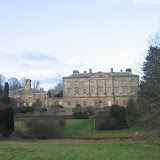 I did say when I began this blog at times it would be about gardening. In this neck of the Republic, the weather remains cold and snowy, so I thought today, to bring some cheer and a hope that spring will eventually be sprung, I would post a small Picassa picture album (click on the link below) taken in February 2007 of Howick Hall and Gardens, Northumberland, a rather more grand garden than most. As this is the first time I have tried posting an album, fingers crossed it works.
I did say when I began this blog at times it would be about gardening. In this neck of the Republic, the weather remains cold and snowy, so I thought today, to bring some cheer and a hope that spring will eventually be sprung, I would post a small Picassa picture album (click on the link below) taken in February 2007 of Howick Hall and Gardens, Northumberland, a rather more grand garden than most. As this is the first time I have tried posting an album, fingers crossed it works. |
| Howick Hall and Gardens Northumberland February 2007 |
The snowdrop walk is also recommended, followed by a visit to the tearooms. Nourishment for soul and body.
http://www.howickhallgardens.org.uk/
http://www.howickhallgardens.org.uk/tearoom.asp
I recommend a pot of Earl Grey tea. The chapel pictured contains his tomb.
There's a monument to him in Newcastle with a statue on top called, not very original I appreciate, Grey's Monument. That's it in the picture above, at the head of Grey Street, voted the finest street in Britain by Radio 4 listeners. Here's a panorama of it:
http://www.bbc.co.uk/tyne/content/panoramas/360_greystreet.shtml
Grey was Prime Minister of England in the 19th century. The 1832 Reform Act was considered by many his greatest achievement. I recall writing an essay about it for my O level history exam.
Here's a little more about him from No 10:
http://www.number10.gov.uk/history-and-tour/prime-ministers-in-history/earl-grey
Several things you may or may not wish to know about Earl Grey:
Earl Grey’s most remarkable achievement was the Reform Act of 1832, which set in train a gradual process of electoral change. Indeed, it sowed the seeds of the system we recognise today.
Around 130 years of parliamentary reform began with this act and culminated in universal suffrage for men and women over 18, secret ballots and legitimate constituencies.
The battle to pass the historic act was a difficult one. Grey resigned after the Lords rejected it, although he returned to office when Wellington found himself unable to form an administration. Wellington then consented, and Grey was able to push the bill through.
Other reforming measures included restrictions on the employment of children, and the abolition of slavery in the British Empire in 1833.
He was said to be ‘tall, slim and strikingly handsome’ although in later years he went bald and wore spectacles.
Mary Elizabeth Ponsonby married the Earl aged 18. Over the next 24 years she remarkably had 16 children yet remained ‘cheerful and good-humoured’ and was devoted to her family. Letters left to her estate show that she had a keen interest in politics and current affairs.
One of Grey’s other legacies is the blend of tea known as Earl Grey. He reputedly received a gift, probably a diplomatic present, of tea that was flavored with bergamot oil.
It became so popular that Grey asked British tea merchants to recreate it.
Which brings me to one of my favourite websites:
http://www.nicecupofteaandasitdown.com/
and not forgetting:
http://www.teawaker.com/
http://www.teasmade.com/
Enjoy!
Back soon.
Nem
(The pic of Grey's Monument above is by Andy Williamson http://www.picturesofgateshead.co.uk/index.html)

















No comments:
Post a Comment